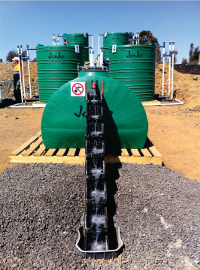 The system that puts oxygen back into the water. The system that puts oxygen back into the water.
Photo: Supplied |
South Africa is one of the most important mining countries in the world, beginning in the 1870s. Although the mining industry has been responsible for significant development and employment, it pollutes the environment and waters sources. Through the joint effort of a well-known mining company, the University of the Free State, and the
Technology Innovation Agency (UFS/TIA) SAENSE Group, a new treatment for Acid Mine Drainage (AMD) has been developed.
The system treats the major contaminants found in acid mining wastewater effectively.
The UFS remediation systems use a reservoir tank into which the AMD is pumped. The water then flows passively (without using energy) to the Barium Carbonate Dispersed Alkaline Substrate (BDAS) system. The metals and anions in the AMD react chemically with the barium carbonate and precipitate (form solids). The solids stay in the tank while the clean water is released.
The efficacy and applicability of the research was demonstrated on site in Belfast, Mpumalanga where the team constructed a pilot plant in July 2014. This patented technology has treated 1 814 400 litres of Acid Mine Drainage to date with an outflow water quality that satisfies the South African National Standards (SANS) 241:2006 & 2011 regulations for drinking water.
Rohan Posthumus from the (UFS/TIA) SAENSE Group said: “At this stage, we do not recommend that the water should be used as drinking water, but certainly it can lower water usage in mines while finding application in dust suppression of washing processes. The team would like to complete a full characterisation of the final released water. There are currently no toxic by-products formed, and even very basic filtration can make the outflow drinking water.”
Prof Esta van Heerden’s research group from the Department of Microbial, Biochemical, and Food Biotechnology has been working on AMD research for some time, but the development of the BDAS system was started in 2013 by post-doctoral student, Dr Julio Castillo, and his junior researcher, Rohan Posthumus.
The data from the BDAS system have led to two publications in peer-reviewed journals as well as a registered patent.